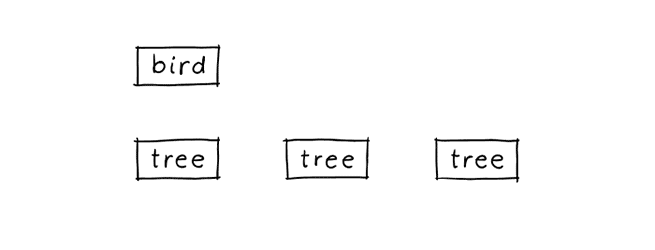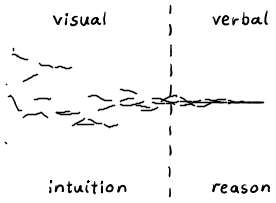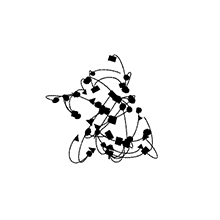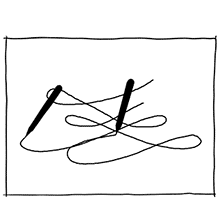An ancient feud rages at the very core of your creative endeavour: The rational logical you and its fuzzy intuitive rival are in constant dispute.

Imagine yourself coming across an old tree.
Baffled by the spectacle of its twigs and branches you could reach out to feel its bark. You observe how the sunlight falls through the countless leaves orchestrating a spectacular pattern of shadows before your feet.
Or you could just think “That’s a tree.” — and move on.

Verbal thinking — Logic
In the second approach we reduce what we see to labels, in our case the label “tree”. We seek closure and only want to know “what it is”. Once we have identified something, we are free to direct our attention and energy elsewhere.

This reduction fosters all sorts of logical and precise reasoning. It‘s great if you want to count trees for instance. But it leaves out a lot.

Visual thinking — Intuition
If we resist the use of labels and actually look at things — then we see a lot more! Our willingness to unlearn lets us discover the affluence of the present situation.

Because we are open to new sensations, we gather a lot more information to make new connections — new ideas. We get an intuitive grasp of the situation and recognise patterns. Thus we can not only handle incredibly complex situations, we can also enjoy them.

Parallel visual thinking is open to complexity. It is fuzzy and less controlled.
Different tasks require different modes of thinking.

Writing software or organising your creative project require a focused linear mindset. Complex tasks such as recognising faces or surviving a dinner party on the other hand are best approached with an intuitive mindset.
Flexible thinking
The key to creativity is to alternate between those two thinking modes. Discern them and become aware of their most successful dedication!
Convergence — from intuition to reason
The basis of any creative activity is to be perceptive. The more you take in, the more ideas can occur in your mind. In phases of perception we are open and abandon any critical restriction or judgment. More is more.

Of course at some point we want to condense all these impressions into something that we can share with others. Following up with a reasonable mindset can help us structure and communicate what we have experienced.
Divergence — from reason to intuition
The reverse is equally important: We first clearly define a creative playground using logical verbal thinking. For instance we might say: “For the next hour I will make drawings of everything that goes through my mind on a single sheet of paper.” After having defined this “creative concept” we can switch into a visual mindset that makes us perceptive enough to capture all those thoughts.

The process of “creative incubation” follows a similar direction: After taking in a lot of information on a subject — in verbal reasonable thinking mode —we let it settle and allow our intuitive side to make new connections in the safety of our subconscious.
What could go wrong?
Many bigger and smaller dramas in our creative process can be ascribed to conflicts between those two different mindsets.
Remember the last time your rational mind pushed your intuitive mind too hard? “Hurry up! Be more creative!”
Intuitive thinking can be seduced or invited, it can hardly be forced. Our rational verbal thinking — being the controlling bully it sometimes is — can disturb or even choke an intuitive process and lead to much dreaded creative block.
On the other hand if we are in a phase where we need to focus and coordinate our ideas, too much intuitive thinking can distract us. The result is utter confusion about what we actually set out to do. We are going nowhere. To quote Sandra Bullock: “I am off structure and I’m drifting!”
So what can we do?
Flexing our minds
Regular habits of intense focus can strengthen our verbal thinking. Examples include reading, studying languages, or one of my personal favourites: writing software. This “dopamine withdrawal” is no small challenge amidst today’s pervasive supply of digital distractions.

Observational drawing on the other hand opens our eyes to the rich information available right here, right now. It helps us find a truly visual language, not a sterile symbolic substitute. I put together a couple of drawing exercises here, should you feel an itch to flex your observational muscles.
Have a look at how you can change your mind to have more ideas here!
Before you go
If you enjoyed this article, then subscribe to my mailing list to receive more animated stories!



3 comments On Seeing vs. reading
Hi, enjoyed the article. I am a long-time software writer, creative writer, consultant, educator etc. Love to exploit multiple thinking modes. I am also currently doing a PhD in design of visual languages for enterprise modelling. Best to you.
Hello, this aricle make me more understand about whats happen in my mind. Especially about conflicts between those two different mindsets, intuition and reason. I do consious now.
Great article.
You are using visual in that one intuitive sense which surely it is. But IMO visual is a bit more.
Visual thinking is the basis of all thinking, For example, programming, when I am thinking about some loop, I draw blocks and it is easier than thinking only in words. In some sense, I am also using a label, not a word, but a diagram, and it is on a level above the intuitive meaning of visual thinking.
But still, visual thinking is more than that.
It is more in technology and it is more in education.
Our education system is discriminative, in many cases replacing everything with text and math.